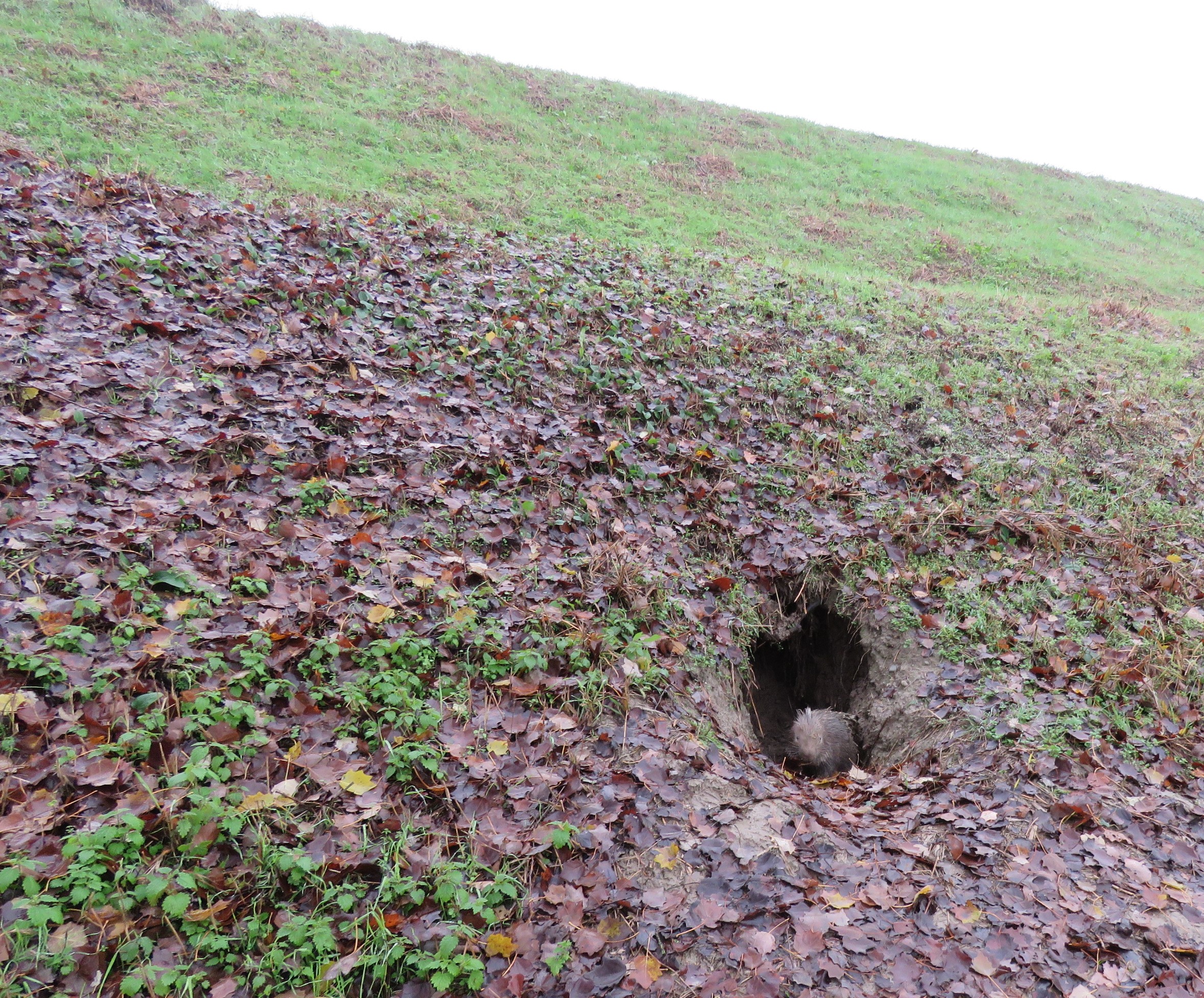Quantifying the likelihood of failure of this protective infrastructure can better protect those living in river floodplains
6 December 2021

Animals such as porcupines that make their dens in the walls of levees can weaken the infrastructure to the point of collapse and flooding, according to new research in Water Resources Research.
Credit: Matteo Balistrocchi.
AGU press contact:
Rebecca Dzombak, +1 (202) 777-7492, [email protected] (UTC-4 hours)
Contact information for the researchers:
Matteo Balistrocchi, University of Modena and Reggio Emilia, [email protected] (UTC+1 hour)
WASHINGTON—Researchers have developed a new method to estimate the risk of levee failure and flooding from burrowing animals like badgers and porcupines.
Levees are human-made embankments usually made from dirt that alter river flow to provide protection to nearby communities. When burrowing animals dig into earthen levees to make their homes, they can weaken the infrastructure to the point of collapse and localized flooding — but most flood risk models don’t take that into account.
Now, a new study, published in the AGU journal Water Resources Research, an interdisciplinary journal that focuses on hydrology and water resources, estimates that risk.
The new study found that levee failure risk depends on the existence or absence of animal dens and where those dens are located throughout the levee. It found that dens at higher elevations in a levee are more dangerous than those near the bottom of the structure.
Flooding from the breaching of levees presents major safety and economic risks. Understanding the likelihood of levee failure can help stakeholders better design, maintain and restore this infrastructure.
“River flooding is a natural phenomenon with no adverse effects when controlled, but when a levee breach occurs it becomes especially threatening because we have concentrated outflows from the river to populated floodplains,” said Matteo Balistrocchi, lead study author and a hydraulic engineer at the University of Modena and Reggio Emilia.
Dangerous dens
Animals seeking shelter often find homes in the dirt walls of a levee, burrowing into their sides and causing a decay of the structure. When river water enters the weakened structure, the levee can fail and cause dangerous, highly localized flooding in the area around the levee.
Levee collapses can cause serious damage to the urbanized areas that the infrastructure is meant to protect. Floods from levee breeches are more severe than normal flooding, as floodwater is not spread out throughout the length of the river but concentrated in the area of the levee breach. Two levee breaches caused by animal bioerosion in Modena, Italy in 2014 and 2020 completely flooded the surrounding villages and each caused an estimated $500 million in damages.
The new study shows that dens dug in the middle of the levee are more dangerous than those dug near the bottom of the levee at the water’s edge. When den elevation increases, it is likely that a larger portion of the levee width is affected, and levee collapse becomes almost certain. Water from flooding inundates the structure and causes excessive seepage, internal erosion, mechanical instability and overflowing.
“While there is considerable concern about these types impacts from burrowing animals, there is a lack of quantitative information and evidence,” said Gemma Harvey, a physical geographer at Queen Mary University of London who was not involved with the new research. “[This research] provides a new modelling approach and quantitative data on levee failure probability that helps us to understand the importance of these impacts.”
In the study sites in northern Italy, these results mean badgers and crested porcupines that find their home higher up in their levees pose a greater threat than local river rats called nutria. But the most damaging animals may also be the most protected: The crested porcupine, for instance, is protected under Italian law, so the rodent has free rein over the levees despite its damaging digging.
“The burrowing activities of animals make many positive contributions to landscapes and ecosystems, including contributions to nutrient cycling and pollution remediation,” Harvey said. “But in certain cases, such as invasive species present in high numbers, or in this case where burrowing interacts directly with flood defense infrastructure such as riverbanks, levees and flood walls, burrowing can create or contribute to environmental hazards.”
The results of this study can potentially help those in charge of levee maintenance better address weaknesses in infrastructure and understand the threat that surveyed dens pose, influencing future approaches to the design and maintenance of flood defense infrastructure.
###
Contributed by Emily Cerf
###
AGU (www.agu.org) supports 130,000 enthusiasts to experts worldwide in Earth and space sciences. Through broad and inclusive partnerships, we advance discovery and solution science that accelerate knowledge and create solutions that are ethical, unbiased and respectful of communities and their values. Our programs include serving as a scholarly publisher, convening virtual and in-person events and providing career support. We live our values in everything we do, such as our net zero energy renovated building in Washington, D.C. and our Ethics and Equity Center, which fosters a diverse and inclusive geoscience community to ensure responsible conduct.
Notes for Journalists:
This research study will be freely available for 30 days. Download a PDF copy of the paper here. Neither the paper nor this press release is under embargo.
Paper title:
“Failure Probability Analysis of Levees Affected by Mammal Bioerosion”
Authors:
- Matteo Balistrocchi (corresponding author), Giovanni Moretti, Stefano Orlandini, Department of Engineering Enzo Ferrari, University of Modena and Reggio Emilia, Modena, Italy
- Roberto Ranzi, Department of Civil Environmental Architectural Engineering and Mathematics, University of Brescia, Brescia, Italy